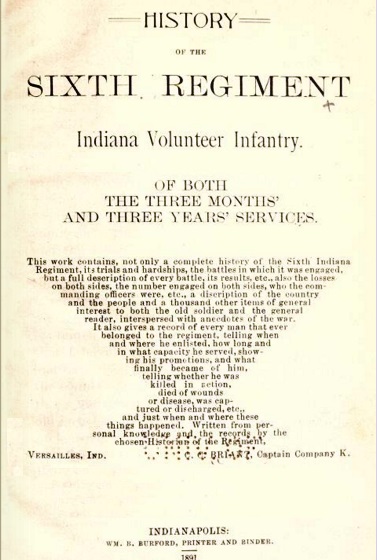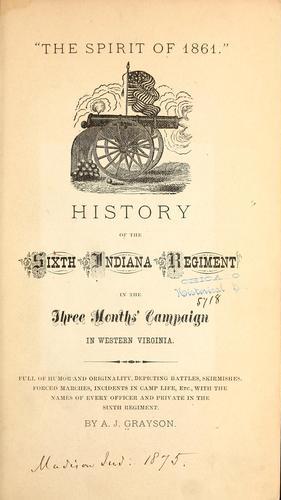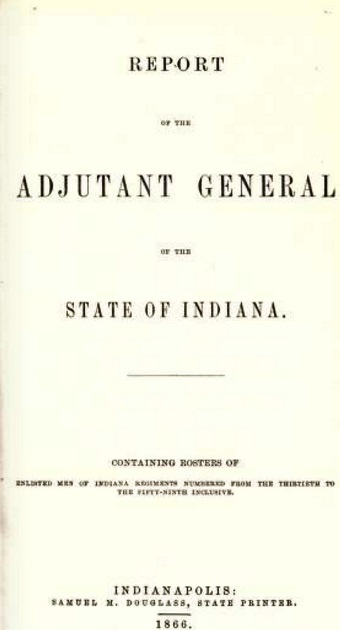HISTORY
of the
VERNON MILITIA
The 1816 Constitution of the new state of Indiana provided for a state militia. Article VII stated “all free, able-bodied male persons... between the ages of eighteen and forty-five years ... shall be equipped and trained as the General Assembly may provide by law.” The Vernon Volunteer Militia formed in 1817 under command of Colonel John Vawter then later went through reorganization in 1824. A company of Vernon Volunteers also formed during the Mexican War of 1846-1848 under the command of Captain Morris Wildey. The Report of the Quarter Master General of the State of Indiana for 1859 lists Wildey’s Vernon Volunteers as receiving a large stand of arms including sixty “Yager rifles” and accoutrements, on August 1, 1846. The Vernon Artillery captained by J. H. Baldwin, had forty flintlock muskets and accoutrements, and a “six -pounder cannon and carriage, complete” on November 19, 1846. The 1859 Report also indicates the annual issue of arms to all organized companies of militia based on the county population, although scant distribution documents exist.
HISTORY
of the
9th REGIMENT (JENNINGS)
3rd BRIGADE - 1st DIVISION INDIANA LEGION
* THE HOME GUARD of JENNINGS COUNTY 1861-1865 *
Chapter 1: “Form Ranks!”
In 1861, Governor Oliver P. Morton gave orders to organize the Indiana Legion and to form companies of uniformed militia to serve the state, primarily to assist in defending the southern border from any and all hazards. Almost every county in Indiana formed companies for the Legion, and some counties raised a sufficient amount of men to form a Regiment.
Our enthusiastic and patriotic citizens answered Governor Morton's call and organized companies in many towns throughout Jennings County, placing themselves under the command of the company elected and state-assigned officers of the First Division, Third Brigade, Ninth Regiment (Jennings) of the Indiana Legion. Once formed under Indiana State Militia Law, the companies followed requirements to elect a Captain, Lieutenants, Sergeants, and Corporals.
Each company also followed requirements to design and supply its own uniforms. Most companies allowed thirty days for new recruits to uniform themselves under company guidelines. Captain Vawter described the Vernon Greys uniform as “A grey coat cut coatee style trimmed with black, similar in all respects to the City Greys of Indianapolis. A grey pair of pants with a black stripe running down the outer seam of the pantaloons. A blue cap - army style.”
It confuses many that Union Militia would wear a grey uniform. History books and Hollywood alike have forced the American Civil War to be defined as a conflict of “blue against grey” for decades. In fact, many Union militias, National Guard, and reserve troops wore grey throughout the conflict, most notably regiments and certainly individual companies formed in New York, Pennsylvania, and of course Indiana.
The 9th Regiment (Jennings) was ordered into service many times during the American Civil War. The typical home guard duties of protecting railroad bridges, federal and state facilities, and other duties necessary for the state’s defense proved just a small portion of the Indiana Legion's actions during the war.
To prepare for these tasks our Regiment needed to drill and practice with the tools of the soldier. After receiving his command rank at the July 20, 1861 election, Major Kennedy Brown ordered all companies in his command to drill at least once a month. The Battalion required Battalion musters and Battalion drill at least three times each year.
Procuring arms and equipment for these citizen soldiers proved difficult during 1861 and through the spring of 1862. Arms of any quality and consistency of caliber were already being issued to the numerous regiments of volunteer infantry that formed in Indiana early in the conflict. The companies of the 9th Regiment not yet armed by June of 1862 would soon carry proper weapons of the soldier in service to the United States.
From July 17 through August 26, 1862, our Regiment guarded Confederate Prisoners of War at Camp Morton. According to the Adjutant General Report Volume No. 8, 650 men promptly responded. The Regiment consisted of ten companies at this time: Captain Solon B. Cowell’s Vernon Greys (Vernon), Captain James Craig’s Bigger Guards (San Jacinto), Captain David W. Moffatt’s Freedom Guards (Vernon), Captain Lewis F. Brougher’s Butlerville Guards (Butlerville), Captain Manlove G. Butler’s Scipio Guards (Scipio), Captain John S. Adam’s Mount Zion Guards (Slate), Captain James Tobias’ Marion Guards (Cana), Captain Calvin W. Dixon’s Paris Guards (Paris), Captain John Evin Wilson’s Cana Cadets (Cana), and Captain Levin W. Hudson’s Jennings Rangers (Slate). After this successful duty, Kennedy Brown was promoted to the rank of Colonel in September 1862.
Immediately following the Regiment’s duty at Camp Morton on August 26, the Scipio Guards under command of Captain Manlove G. Butler reenlisted for four weeks extended duty to escort exchanged Confederate prisoners down the Ohio and Mississippi Rivers to Vicksburg, Mississippi. According to the 1862 reports, three Jennings County soldiers are reported as casualties - two to disease and one reportedly pushed overboard by angry Confederate prisoners. Research to date has not revealed the names of these men. The Scipio Guards returned home on September 26, 1862.
Kennedy Brown reported that during an alarm in late 1862: “In less than eighteen hours after I received the order, my command was massed at Vernon, ready to go wherever called or needed.”
In September 1862, the Bigger Guards sported “31 French rifle muskets” at their fall muster. In October 1862, the Marion Guards possessed “51 French rifle muskets,” and the Bigger Guards now armed themselves with “66 altered to percussion muskets, caliber .69 inches.” The Paris Guards drilled with “60 Austrian rifle muskets, caliber .54 inches.” The Scipio Guards carried arms similar to the Paris Guards with “50 Austrian rifle muskets.”
The various types of arms and ammunition in use by the Indiana Legion proved to be a logistical nightmare for the Quartermaster General. Our Regiment alone possessed weapons in three different calibers at one point, some arms requiring “ball” ammunition and others requiring “minié bullets” in various calibers.
The 9th Regiment (Jennings) Report of December 19, 1862 lists “some six or seven companies” as being fully armed according to Colonel Brown.
On March 23, 1863, the Quartermaster General collected all the state arms in Jennings County for cataloging and inspection. This left our Regiment without arms from March 23 to July 9, 1863, but the active companies still drilled monthly, and the Regiment held a Battalion muster on April 13, 1863 with each company report stating “no arms.” The Regiment boasted over 500 men at this muster, and in a few months these soldiers will be tested once again.
Chapter 2: The Great Emergency of 1863
From July 8 through July 13, 1863, Confederate General John Hunt Morgan and approximately 3,000 mounted Confederate soldiers rode their way through Southern Indiana, spreading havoc throughout.
The 9th Regiment (Jennings) Command documented as active nine days “for defending the State during the raid by the Rebel forces under General John Morgan” Colonel Kennedy Brown, Lt. Colonel Calvin R. Dixon, and Major Levin Hudson. Quartermaster James Passmore, Adjutant S.W. Story, Surgeon S.H. Green, and Sergeant Major Peter Bradshaw are also listed on duty for nine days.
The fourteen companies documented as active during the raid for nine days are Captain John E. Wilson’s Cana Cadets, Captain Leonard Ennis’ Morton Guards, Captain A.W. Boyd’s Butlerville Minutemen (Captain Boyd nine days, his men five days), Captain John S. Adams’ Mount Zion Guards, Captain Joshua H. Shepherd’s Graham Guards, Captain Lewis F. Brougher’s Butlerville Guards, Captain Manlove G. Butler’s Scipio Guards, Captain James R. Craig’s Bigger Guards, Captain Joseph E. Smith’s Queensville Guards, Captain George W. Adam’s Jennings Rangers, Captain James H. Wilson’s Paris Guards, Captain Solon B. Cowell’s Vernon Greys, Captain James Tobias Marion Guards, and Captain James T. Spaulding’s Freedom Guards.
On July 9, 1863, Colonel Kennedy Brown immediately reacted to the alarm and made arrangements to re-arm and re-supply the 9th Regiment (Jennings) Indiana Legion. Colonel Brown sent a telegram early on July 9 and requested 600 muskets and 20,000 rounds of ammunition and rations for the Regiment.
The Adjutant General quickly complied, and the Regiment received 600 French rifle muskets caliber .69, cartridge boxes, cartridge box belts with plates, cap pouches, waist belts and plates, bayonets and scabbards, and tools and equipment to maintain these stands of arms at 8:00 P.M. the same day. Colonel Brown was probably dismayed at the amount of ammunition received. Only 7,000 rounds of minié bullets arrived. - a scant fourteen rounds per man! (NOTE: This stand of arms will remain in the Regiment and Company armories until September 1865. Ammunition was rarely reported in short supply hereafter.)
On July 10, 1863, our Regiment, placed under the command of General James Hughes, left by rail for Mitchell, Indiana. Our regiment would be sent back to Seymour later on July 11, 1863.
Confusing and misleading reports about Morgan and the direction taken by his forces flooded the Governor’s office. Some telegraphed reports stated that Morgan was attempting to escape the Legion forces by way of Madison, causing great anxiety amongst the citizens of Jefferson and Jennings Counties.
Smith Vawter, who later joined the Vernon Greys on July 11 as a private, wired Governor Morton directly on July 10, 1863: “Our Legion has been ordered away. Can people here do anything to prevent his escape?”
The reply from Morton said simply to organize and prepare. Our citizens went immediately into action, armed themselves with any weapons available, and formed numerous scouting parties to search the countryside for any sign of Morgan and his Raiders. They did not need to search far. Morgan placed almost 400 skirmishers around Vernon to mask the movements of his main body on the Richland Road, about one mile south of Vernon.
Being described in the report of General Mansfield as “some troops from Jennings County,” or as also described by General Love in his report as “the armed citizens of Jennings County,” about 100 citizen soldiers armed with their own squirrel rifles, shotguns, and pistols hastily organized and prepared defenses on the hills and bluffs surrounding Vernon. These Jennings County men joined with the forces of Colonel Hugh Williams of the 11th Regiment Indiana Legion to halt Morgan and his Raiders at Vernon.
In epic fashion, and truly being one of the most notable occurrences during this emergency, this tiny combined force of perhaps just 100 Jennings County citizen soldiers and the 178 men and officers of the 11th Regiment Indiana Legion twice refused to surrender the town on July 11, 1863.
Colonel Hugh Williams had senior command of all the forces assembled in Vernon on July 11 until General Love arrived, and a historic plaque on display in Vernon makes note of the Colonel’s July 18, 1863 report. Vernon would indeed only be taken by “hard fighting,” but no major engagement ensued. With Hobson’s Cavalry (Union) on his heels, the Raiders found themselves now stuck between a rock and a hard place.
General John Love of the Indiana Legion leading 1,000 Indiana Legion “Minute Men,” Indiana Infantry, and Michigan infantry marched into Vernon on July 11, 1863 at approximately 5:00 P.M., just as Morgan demanded the surrender of Vernon for the second time.
Morgan finally turned south, having no desire to engage such a large force well deployed on good ground. Trying desperately to escape Indiana by riding south through Madison, Morgan and his Raiders will soon run into the 9th Regiment (Jefferson) Indiana Legion, their 1,100 men now well deployed on a good defensive line just six miles North of Madison. The 9th Regiment (Jefferson) made sure Morgan could not safely cross the Ohio River into Kentucky. Morgan’s Raiders then turned east, seeking another escape from the Indiana Legion.
General Hughes held our 9th Regiment (Jennings) held in Seymour. With rumors circulating through the ranks that Morgan’s men had burned and looted homes in Jennings County, Colonel Kennedy Brown wired Governor Morton directly on July 11, 1863: “General Wilcox order for General Hughes to proceed to Columbus to guard bridges is causing great dissatisfaction in my command. We have 500 Jennings County men with us that believe Morgan is ravaging their homes. Do have General Wilcox to withdraw the order and allow General Hughes to march for North Vernon.”
The order to guard Columbus countermanded, our Regiment prepared to load into box cars and return to Vernon. The 500 man force of the 9th Regiment (Jennings) finally received orders to return to Vernon, arriving home near midnight on July 11/12, 1863.
At 1:00 A.M. on July 12, 1863, General Love ordered Captain A.W. Boyd and twenty mounted citizen soldiers of the “Butlerville Minute Men” to scout towards Dupont and ascertain the position of Morgan. These men of the 9th Regiment (Jennings) returned to Vernon at 8:00 A.M. on July 12 with valuable information of the condition and whereabouts of the confederate forces - along with sixteen confederate prisoners, fifty horses, one hundred muskets, twenty revolvers, and other captured confederate equipment. General Love made special note of this successful mission in his official report to the Governor.
Sometime around 9:00 A.M. on July 12, General Lew Wallace arrived in Vernon with additional forces and took command.
The 102nd, 103rd, 112th, 113th, and 114th Regiment of Indiana Legion “Minute Men” reported being stationed in North Vernon on July 13, 1863, fully armed and equipped to pursue Morgan’s Raiders by rail to Osgood, and then by forced march to Sunman. Our Regiment regrouped in Vernon prior to joining these and other forces gathered in North Vernon to execute the eastward pursuit of the Raiders.
With the Indiana Legion massed and equipped to engage them, Morgan and his Raiders moved into Ohio The infamous “Morgan’s Raid” ended in failure for the confederate cavalier, with he and a large portion of his command imprisoned. Morgan did manage to later escape his prison cell, and he will once again be raiding and pillaging Kentucky, and threatening to do the same on Indiana soil.
The reports of Indiana Legion General John Love and Colonel Hugh Williams stated high regard for the “armed citizens of Jennings County,” and contained equally high praise for the behavior of the citizens of Vernon during the infamous “Morgan’s Raid.” The entire 9th Regiment (Jennings) returned home by July 17, 1863.
Chapter 3: The Emergency of June 1864
On June 9, 1864, General John Morgan once again raided northern Kentucky and postured to invade Indiana soil to revenge his failed attempt at glory just eleven months prior.
Our Regiment once again answered a call into service to defend our borders. On June 11, 1864 the 9th Regiment (Jennings) rode the rails to Madison to join with their fellow citizen soldiers of the 9th Regiment (Jefferson) Indiana Legion. The mission of this combined force numbering near 1,500 men at arms was to defend the Madison area and to be ready and equipped for possible transport to Jeffersonville and Louisville if needed.
The eleven companies of the 9th Regiment (Jennings) who participated in this mission were Captain Solon B. Cowell’s Vernon Greys, Captain James T. Spaulding’s Freedom Guards, Captain Luther Davis’ Butlerville Guards, Captain James Craig’s Bigger Guards, Captain Manlove G. Butler’s Scipio Guards, Captain Joseph B. Smith’s Queensville Guards, Captain Allen W. Lett’s Mount Zion Guards, Captain James H. Wilson’s Paris Guards, Captain George W. Adams’ Jennings Rangers, Captain William F. Carpenter’s Wolf Creek Scouts (formed in August 1863 ), and Captain William Stewart’s Marion Guards.
This emergency turned out to be a false alarm with but a few skirmishes in Kentucky and Southeast Indiana, so both Regiments received orders to cease operations, resulting in our Regiment returning home on June 14, 1864 with no incidents reported.
A show of force seemed all that was necessary to keep the confederate forces in check and our borders secure. Our Regiment adds another successful mission to its now long list of achievements.
Letter to Governor Morton describing Greys uniform.
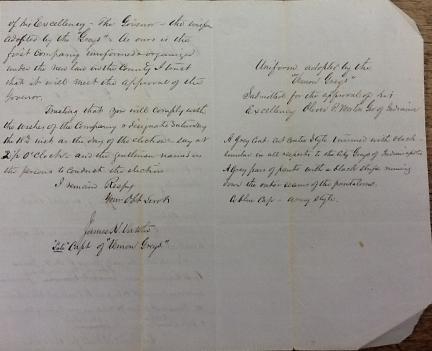
The 9th Regiment (Jennings) Indiana Legion Companies as formed in 1861:
| Vernon Greys | Capt. James H. Vawter (Vernon) | ||||||||
| Freedom Guards | Capt. David W. Moffatt (Vernon) | ||||||||
| Butlerville Guards | Capt. Calvin D. Campbell (Butlerville) | ||||||||
| Bigger Guards | Capt. Thomas C. Bachelor (San Jacinto) | ||||||||
| Scipio Guards | Capt. Kennedy Brown (Scipio) | ||||||||
| Weston Guards | Capt. John Meek | ||||||||
| Queensville Guards | Capt. Joseph B. Smith (Queensville) | ||||||||
| Mount Zion Guards | Capt. John S. Adams (Slate) | ||||||||
| Paris Guards | Capt. Calvin W. R. Dixon (Paris) | ||||||||
| Jennings Rangers | Capt. Allen Hill (Slate) | ||||||||
| Marion Guards | Capt. James Tobias (Cana) | ||||||||
| Graham Guards | Capt. Joshua H. Shepherd (Hopewell) | ||||||||
| Cana Cadets | Capt. John E. Wilson (Cana) | ||||||||
| Morton Guards | Capt. Leonard Enis (North Vernon) | ||||||||
| Wolf Creek Scouts | Capt. William F. Carpenter (Zenas) |
Roster of Company A “Vernon Greys” in July 1862
Captain
Cowell, Solon B.
First Lieutenant
Campbell, Solon B.
Second Lieutenant
Denhsun, Thomas B.
First Sergeant
Westover, James P.
Sergeants
Cowell, John Q.
Gasaway, George W.
Ditlinger, Nicholas
Burgess, Henry
Corporals
Shields Charles Brown
Patrick, Daniel
Buchanan, John J
Saupe, Frederick F,
Wagoner.
Wilson, James H
Privates.
Aple, Charles
Buchanan, James G.
Buchanan, William P.
Bundy, John.
Bolser, Hallet S.
Brown, Joshua
Carroll, John.
Carroll, George.
Cornelius, Augustus.
Curtis, John C.
Curtis, Charles B.
Dixon, William C.
Eckstine, Robert O.
Foster, Thomas
Foster, Edward
Feagler, James
Goddard, Robert L.
Hilton, James
Jordan, Winsel
Jordan. John
King, Charles
Morledge, Roger B.
McCammon, Francis
Osborn, Benjamin F.
Patrick, Thomas
Raemfolder, Frederick
Rowley, James
Smyth, John
Skinner, Stephen
Todhunter, James M.
Thixton, Moses
Watson, James
Wilson, John A.
Weaver, David
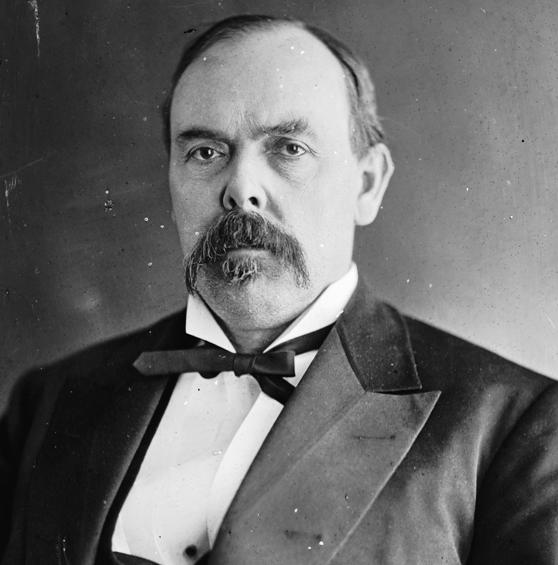
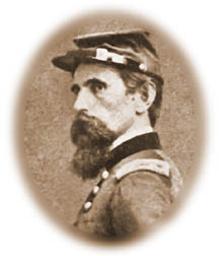
Indiana Governor Oliver Hazard Perry Morton
Major General Lew Wallace
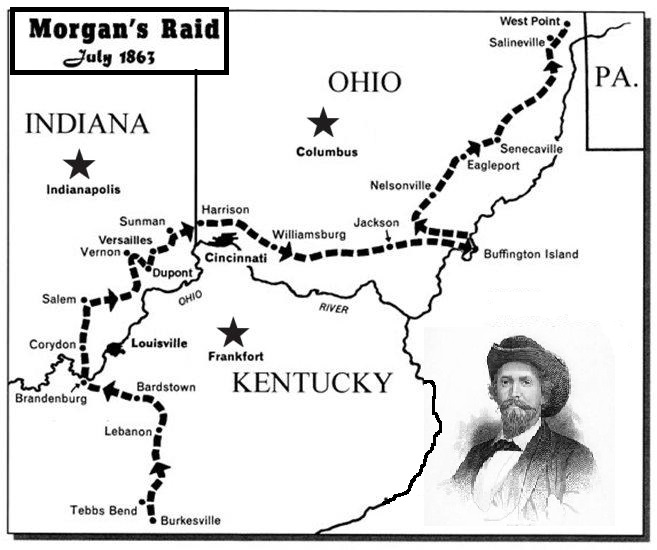
Map of Morgan’s Raid Through KY, IN, & OH
Historical Marker at Jennings County Courthouse
Sources:
Etter, John P. The Indiana Legion: A Civil War Militia. Carmel, Indiana: Hawthorne Pub., 2006. Print.
Geeting, D.M. Constitutions of 1816 and 1851 of the State of Indiana and Amendments. Indianapolis: William B. Burford, State Printer, 1898. Print
Governor Oliver P. Morton Telegraph Books 1861-1865: General Dispatch #11 5/10/1863 – 1/11/1863 and General Dispatch #12 7/11/1863 – 12/24/1863. Indiana State Library, Indianapolis. Web
Jennings County Indiana Legion Papers. Indiana State Archives, Commission on Public Records, Indianapolis. (NOTE: Now contained within two volumes of microfilm at the Jennings County Public Library.)
Operations of the Indiana Legion and Minute Men, 1863-4. Documents Presented to the General Assembly, with the Governor’s Message, January 6, 1865. Indianapolis: W.R. Holloway, State Printer, 1865. Print.
Report of the Quarter Master General of the State of Indiana, in Reply to a Resolution of the Senate. Indianapolis: John C. Walker, State Printer, 1859. Print.
Rice, Tom. Legacy of Honor: Volume 1 and Volume 2. Vernon, Indiana: Jennings County Historical Society / Our Heritage, Inc., 2011. Print.
Terrell, William Henry Harrison. Report of the Adjutant General of the State of Indiana (Volumes 1 -8). Indianapolis: A.H. Connor (etc.) State Printer, 1865. Print.

of the
6th REGIMENT INDIANA VOLUNTEER INFANTRY
Three Months Service
The Sixth regiment was organized and mustered into service, for three months, at Indianapolis, Indiana April 25, 1861, with Thomas T. Crittenden, of Madison, as colonel. It was one of the six regiments of three months' men organized by Gov. Oliver P. Morton under the call of President Lincoln for 75,000 men. On May 30, the regiment left Indianapolis, Indiana, via Cincinnati, Ohio and Parkersburg, West Virginia for the scene of conflict in Western Virginia being first fully armed, equipped and clothed. Arriving at Webster, West Virginia on June 2, it was marched with other troops, the same night, through a drenching rain, a distance of fourteen miles, and, on the morning of June 3, took part in the first battle of the war, at Philippi, West Virginia. Returning to Grafton, West Virginia it was made part of General Thomas A. Morris’ Brigade, and participated in the march to Laurel Hill and the engagement with Granett’s rebel command at Carrick’s Ford on July 12. The latter part of the same month the Regiment returned to Indianapolis, Indiana where it was finally discharged August 2, 1861.
Three Years Service
The Sixth Regiment was re-organized for the three years’ service, at Madison, on September 20, 1861. On the same day Colonel Thomas T. Crittenden, its commanding officer, obtained permission to take what men were then in camp (about five hundred), to Kentucky, then invaded by the rebel forces under Buckner. Without waiting for uniforms, this portion of the Sixth Regiment took steamer for Louisville, reaching there the same evening, was the first body of troops to enter Kentucky from a northern State. Immediately on its arrival it was dispatched, by way of the Nashville Railroad, to Muldraugh’s Hill, Forty miles from Louisville, and camped at a point a few miles north of Elizabethtown, on September 22. On the arrival of the Louisville Legion, and the 38th and 39th Indiana Regiments, the 6th was moved beyond Elizabethtown and posted in the advance near Nilon creek. Here it was joined by three hundred recruits, which had left Madison on October 9, in charge of Lieutenant Colonel Hiram Prather. A large force of Union troops was soon concentrated in this vicinity, where Brigade and Division organizations were perfected. The Sixth was assigned to Rousseau’s Bridge on McCook’s Division, and marched with this portion of Buell’s army to Munfordsville, Woodsonville, and Bowling Green, remaining at the latter place until March, 1862, when it marched to Nashville, and went into camp near that city. On March 29, it left for the Tennessee River, reaching Savannah, Tennessee, after a march of one hundred and forty miles in seven days, on the morning of April 7, in time to take a steamer and reach the field of Shiloh early in the morning of the second day of that great battle. Rousseau’s Brigade was assigned a position near the center of the line of battle. The Sixth fought gallantly, and at a critical period saved one of our batteries from capture, following this up with a charge that aided in turning the tide of victory in favor of our arms. After the battle, it encamped upon the field, reaming there until the march upon and siege of Corinth was commenced, in which it participated. The Regiment then marched, with Buell’s army, to Nashville, by the way of Tuscumbia, Florence, Huntsville, Stevenson, and Cowan's Station, and from thence to Louisville, Kentucky, reaching the latter place on October 2, 1862. November found the Sixth again in Tennessee, when it participated in Rosecrans march upon Murfreesboro, and in the battle of Stone River, December 31, 1862, and January 1 and 2, 1863.
During the spring and summer of 1863, the Sixth Regiment was engaged in campaigning in the district country lying between Murfreesboro and Chattanooga, Tennessee. On September 19 and 20, it participated in the battle of Chickamauga. The Commanding officer, Col. Philemon P. Baldwin was killed on the first day of the engagement. It was, also, engaged in a severe skirmish with the enemy at Brown’s Ferry, Tennessee, on October 27, and in the successful engagement at Mission Ridge on November 25. The Regiment was then marched into East Tennessee, and remained in that locality until the following spring.
In the march upon Atlanta, Georgia, and the severe fighting that ensued, from day to day, the Sixth bore an honorable part. It was engaged in the battles at Tunnel Hill, Rock Face Ridge, Resaca, Buzzard Roost, Dallas, New Hope, Allatoona Ridge, Kennesaw Mountain, Marietta, and before Atlanta. In the latter part of August 1864, it returned to Chattanooga, Tennessee, where the non-veterans were mustered out of service on September 22, 1864. The few remaining veterans and the recruits whose term of service had not expired were transferred to the 68th Regiment Indiana Volunteers. On the final muster out of the last names Regiment, nineteen men of the old Sixth were found to be still in service, and these were again transferred to the 44th Regiment Indiana Volunteers, and were finally mustered out with that organization on September 14, 1865.
Overview Three Years Service
Regiment organized at Madison, IN, and mustered in September 20, 1861. Ordered to Louisville, KY, September 20. Duty at Muldraugh’s Hill until October 14. Moved to Nolin River, KY. Duty at Bacon Creek and Green River until February, 1862. Attached to 1st Brigade, McCook’s Command, at Nolin, KY, October-November, 1861. 4th Brigade, Army of the Ohio, to December, 1861. 4th Brigade, 2nd Division, Army of the Ohio, to September, 1862. 4th Brigade, 2nd Division, 1st Corps, Army of the Ohio, to November, 1862. 3rd Brigade, 2nd Division, Right Wing Army Corps, Army of the Cumberland, to January, 1863. 3rd Brigade, 2nd Division, 20th Army Corps, Army of the Cumberland, to October, 1863. 2nd Brigade, 3rd Division, 4th Army Corps, Army of the Cumberland, to September 22, 1864.
OFFICERS (3 MONTHS SERVICE)
Col. Thomas T. Crittenden (Madison)
Lieut. Col. Hiram Prather (North Vernon)
Maj. John Gerber (Madison)
Company A.
Capt. Philemon P. Baldwin (Madison)
Company B.
Capt. Augustus H. Abbett (Columbus)
Company C.
Capt. Charles Childs (Washington)
Company D.
Capt. Thomas J. Harrison (Kokomo)
Company E.
Capt. Jeremiah C. Sullivan (Madison)
Capt. Rufus Gale (Madison)
Company F.
Capt. William C. Morean (Knightstown)
Company G.
Capt. Hagerman Tripp (North Vernon)
Company H.
Capt. Fielder A. Jones (Seymour)
Company I.
Capt. John D. Evans (Noblesville)
Company K.
Capt. Alois O. Bachman (Madison)
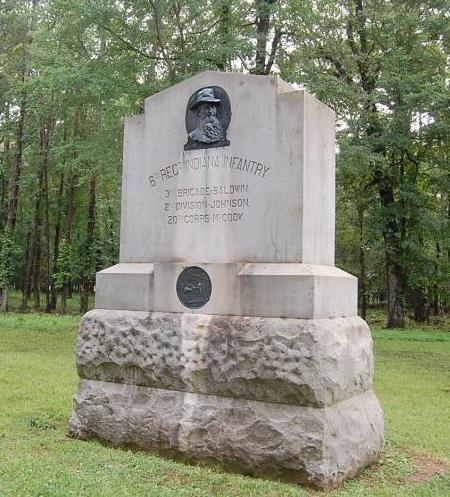
Indiana’s tribute to the Sixth Regiment Infantry for its efforts at the Battle of Chickamauga.
OFFICERS (3 YEARS SERVICE)
Col. Thomas T. Crittenden (Madison)
Col. Philemon P. Baldwin (Madison)
Col. Hagerman Tripp (North Vernon)
Lt. Col. Hiram Prather (NorthVernon)
Lt. Col. Calvin D. Campbell (Butlerville)
Maj. Augustus H. Abbett (Columbus)
Maj. Samuel F. McKeehan (NorthVernon)
Maj. Delany Kavanaugh (Madison)
Company A.
Captain James C. Whaley (Madison)
Company B.
Captain Pleasant C. McGannon (North Vernon)
Company C.
Captain Alan W. Prather (Columbus)
Captain William A. Cummings (Columbus)
Company D.
Captain Samuel Russell (Madison)
Captain Andrew F. Conner (Madison)
Captain William P. Dillon (Madison)
Company E.
Captain Charles R.Van Trees (Washington)
Captain Oscar F. Rodarmel (Washington)
Company F.
Captain John R.B. Glasscock (Madison)
Captain Andrew J. Newland (Madison)
Captain Moses Crawford (Madison)
Company G.
Captain James Moffat (Elizabethtown)
Captain Samuel T. Finney (Elizabethtown)
Company H.
Captain William M. Davis (Bennington)
Captain John Charlton (Bennington)
Captain John Earnshaw (Madison)
Captain Frank P. Strader (Madison)
Captain James F. Simpson (Bennington)
Company I.
Captain Silas D. Huckleberry (Butlerville)
Captain Daniel W. Conner (Butlerville)
Company K.
Captain George W Brown (Holton)
Captain Charles C. Briant (Holton)
6th Regiment Company B (Jennings County) 1861
| Captain. | Privates. | Jayne, Stephen. | Sucese, John P. |
| Hagerman Tripp | Adkins, Edward M. | Jayne, Stephen H. | Swift, Samuel C. |
| Banks, Oliver | Jayne, Morris S. | Tillman, Hezekiah | |
| First Lieutenant. | Batey, Allen | Jayne, Seeley | Tripp, Jasper |
| Samuel McKeehan | Bay, David | Johnson, Theodore | Twaddle, Walter S. |
| Beck, William | Jolly, William | Tungat, William | |
| Second Lieutenant. | Burge, James R. | Kaine, James | Walton, Gideon |
| Francis M. Rust | Burge, Robert | Kaine, John | Walker, William B. |
| Burroughs, James P. | Kelly, Jerome | Walker, Leander T. | |
| First Sergeant. | Clements, Alexander | King, Jeptha | Whitmore, Oliver S. |
| Hinshaw, Jonathan P. | Clements, Edward | Kitts, James S. | Whitmore, Caleb |
| Cordwell, John | Lang, Stephen H. | Wilson, John B. | |
| Sergeants. | Cox, Robert | Lamphire, Lorenzo | Wilson, Samuel |
| Patterson, John T. | Day, Daniel D. | Literal, George | Wilson, David A. |
| Prather, Alonzo S. | Derringer, Lorenzo D. | Mahan, Jacob | Young, Robert |
| Burge, Henry J. | Doxon, John | Mahan, John C. | |
| McGannon, Pleasant C. | Downs, Leonard | Marcin, Robert | |
| Downs, William | Marlett, James | ||
| Corporals. | Dye, Wesley W. | McLellan, John. | |
| Carson, William M. | Elzea, Harrison | McGinty, Michael. | |
| Allen, George F. | Foster, Robert | Monroe, Arthur. | |
| Grinsted, Daniel. | Gannon, Lewi. | Monroe, John, Jr. | |
| Tillman, John | Gest, George W. | Monroe, John, Sr. | |
| O’Hair, Peter | Grinstead, Marshall. | Monroe, Philip. | |
| Monroe, George O. | Grinstead, Wirt | Monroe, Thomas B. | |
| Spilker, Frederick | Hall, Isaac | Murphy, James, | |
| Pope, Henry E. | Hargrove, Benjamin F | Patterson, William B. | |
| Harrington, George W. | Pender, Robert | ||
| Musicians. | Henry, Stanford J. | Riley, James B. | |
| Rose, William | Higby, Charles R. | Rowdehush, Daniel | |
| Kimbel, James | Hooker, Willem H. | Sears, James I. | |
| Howe, Lewis. | Shepherd, John S. | ||
| Wagoner. | Hulse, Jeremiah | Shewmaker, James T. | |
| Wilder, Samuel H | James, Thomas S. | Shrewsbury, William P. | |

Sources:
Briant, Charles C. History of the Sixth Regiment Indiana Volunteer Infantry. Indianapolis: W.B. Buford Publishing, 1891. Web.
Grayson, Andrew J. The Spirit of 1861. Madison, Indiana: Madison Courier Publishing, 1875. Web.
Terrell, William Henry Harrison. Report of the Adjutant General of the State of Indiana (Volumes 1 -8). Indianapolis: A.H. Connor [etc.] State Printer, 1865. Web.
6th Indiana Flags at the Indiana Battle Flag Museum
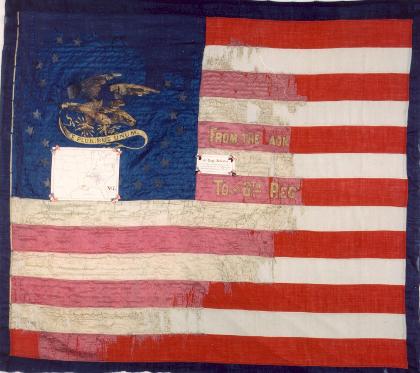
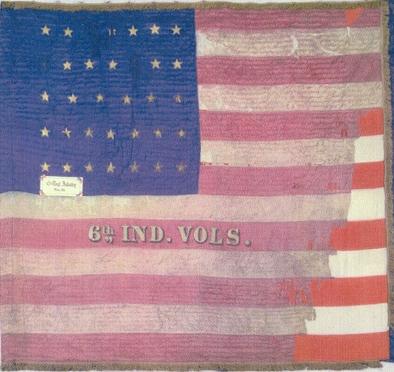
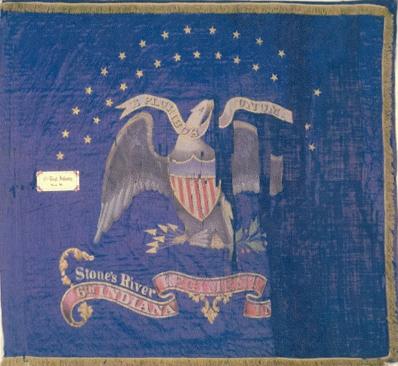
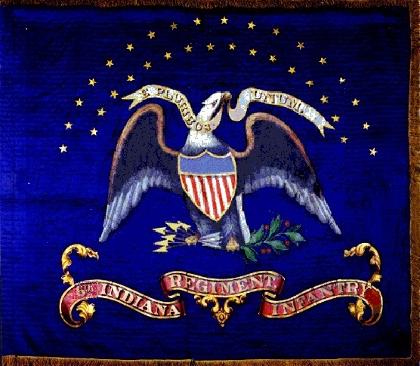
This flag is a conglomeration to reconstruct the 6th Indiana’s.
Links to Sources at archive.org
ALL PHOTOS (UNLESS OTHERWISE NOTED) ARE THE PROPERTY OF THE VERNON GREYS & 6th IN.
